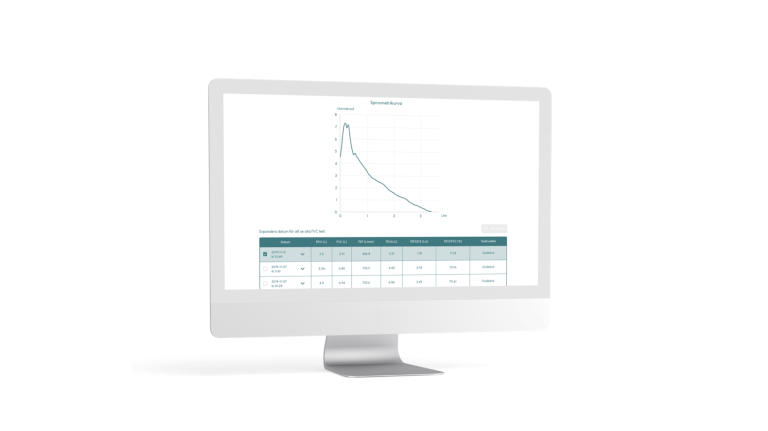What are lung function tests?
Lung function tests are assessments that provide a quick picture of how your lungs are working at the moment. By measuring different values, healthcare providers gain important information about your lungs and airways. The most common values from spirometry are FEV1, FVC, FEV6, PEF and FEF25-75, each offering insights into your lung health.
FEV1 – Forced expiratory volume in the first second
What is FEV1?
FEV1 is the amount of air you can blow out of your lungs in the first second of a forceful exhalation. FEV1 is important because it shows how quickly your airways can empty air.
What does the value mean?
Lower FEV1 values can indicate reduced lung function, as seen in asthma or COPD (chronic obstructive pulmonary disease). FEV1 is, therefore, a key value for understanding if there are any blockages in your airways.
FVC – Forced vital capacity
What is FVC?
FVC measures the total amount of air you can blow out after taking a deep breath and then exhaling as forcefully and quickly as possible. This value reflects the total capacity of your lungs.
What does the value mean?
If the FVC value is low, it may indicate that the lungs have a lower volume or that lung tissue is not elastic enough. FVC is often used to check for signs of restrictive lung diseases, which affect the lungs' ability to fully expand.
FEV6 – Forced Expiratory Volume in six seconds
What is FEV6?
FEV6 shows how much air you can blow out from your lungs in six seconds. This value can be used instead of FVC in certain tests, as it is often easier to achieve similar results with a shorter exhalation time.
What does the value mean?
FEV6 is sometimes used as an alternative to FVC, especially when it is difficult for the patient to exhale for a longer period. It can provide a good indication of lung capacity and is particularly useful in lung function screening.
PEF – Peak Expiratory Flow
What is PEF?
PEF measures the maximum speed at which you can blow air out of your lungs. This value shows how quickly air leaves the airways and is important for understanding how narrow or open the airways are.
What does the value mean?
A low PEF value can indicate narrowed airways, often seen in asthma and other airway issues. PEF is frequently used to monitor asthma and can help identify if symptoms are worsening.
FEF25-75 – Forced expiratory flow at 25-75% of FVC
What is FEF25-75?
FEF25-75 measures the average airflow during the middle portion of a forced exhalation, specifically between 25% and 75% of the FVC. This value focuses on the small airways in your lungs.
What does the value mean?
A lower FEF25-75 value can indicate early changes in small airway function, even before FEV1 or FVC values are affected. This can be a sign of early-stage conditions like asthma or COPD. While not always used as a primary diagnostic tool, FEF25-75 provides valuable additional information about small airway health.
Summary: Lung function values for better health
These values—FEV1, FVC, FEV6, PEF and FEF25-75—together provide a detailed picture of how your lungs are functioning and help healthcare providers assess your lung capacity. By tracking these values over time, you and your healthcare provider can gain a better understanding of your lung status and adjust your treatment if needed. Don’t hesitate to ask your healthcare provider if you need help interpreting your test results and advice on how to improve your lung function!





